Zuccaro en
Aus Mediathek des IKB
Concept


ZUCCARO is a project for a digital platform for historical and cultural data. The project is carried out by the Bibliotheca Hertziana, Max Planck Institute for Art History, Rome. Since 2012, there has been a cooperation with the Institute of Art and History of the Humboldt-Universität in Berlin.
Research projects at the Bibliotheca Hertziana, which include the systematic documentation certain types of artefacts (Lineamenta, ArsRoma) formed a starting point for ZUCCARO. During the implementation of the requirements, the underlying data model has increasingly developed into a universal documentation model. This process was also inspired by earlier projects in art history, particularly the Census of Antique Works of Art and Architecture..., as well as by the Cidoc CRM (Conceptional Reference Model).
The data model is based on logical triples and aims to link basic entities by qualified relationships. As they also include the time factor, the model is event-oriented. The extraordinary advantage of such a model lies in the fact that it leaves behind the tradition of the static description of artefacts, while at the same time the history of the artefacts becomes the focus of interest. Issues like production processes, change of ownership and provenances, exhibitions and other events can be reproduced easily. The generalized structure of the model guarantees a free choice of perspective, so that the documented facts can equally be displayed and examined with a focus on artefacts, persons, institutions, or geography.
The net-shaped structure, built on strictly normalized entities, ensures connectivity to external data collections (such as collection catalogs of a museum, editions of source texts, or individual databases). However, connection to external knowledge systems does not require direct linking, but can be provided via identifiers of authority files or – better said - persistant reference repositories. In particular, the open and extensible knowledge base Wikidata can function like a hub for further information and connection to the rest of the web. Finally, the formalized data structure also allows the use of quantitative methods in terms of a social and economic history.
History of the project
Since 2003: A small working group (among others, Martin Raspe, Georg Schelbert) is developing a data model for ZUCCARO at Bibliotheca Hertziana on the basis of the requirements of the research projects Lineamenta and ArsRoma.
2004: Implementation of the data model as a proof of concept in a relational database management system (Filemaker Pro, as a client-server architecture). Since 2005 up to the present time (Dec. 2016), research data are collected and processed with this system.
2005-2010: Cooperation with the University of Trier (Georg Schelbert) as part of the project Lineamenta
2008: Implementation of a web interface with xslt technology (by Martin Raspe).
2010: An application for funding in the DFG program "Information Infrastructures for Research Data" was not accepted.
Since 2011: cooperation with Humboldt-Universität in Berlin (Georg Schelbert) as part of the project Lineamenta. Since 2016 this cooperation is a part of the project Zuccaro
Since 2013: work on the implementation of the model in a graph database system (Neo4J). The system which is designed as open-source software should then be freely available (Martin Raspe, Georg Schelbert).
Online-Access
- ZUCCARO Homepage, since 2003
- ZUCCARO preliminary online database, since 2008.
Example Queries
(please note that fieldnames and a major part of the data is in German)

Stored queries (pdfs)
(fast download, statical; date as shown on pdf)
People
- early photographers in Rome (sortorder: date of birth) (1.2017)
Works of Art and Architecture
- chapels in Rome; sortorder: by geographical position form NW to SE: [1] (1.2017)
- Cardinal and Papal tombs (1.2017)
- Artwork with complex provenance: Julius Schnorr von Carolsfeld: portrait of Friedrich Olivier (1.2017)
- The prints of the Bibliotheca Hertziana's Speculum Romanae Magnificentiae (collection by Antoine Laféry, 1575 ca.).
- Maps of Paris (1.2017)
- Buildings which are related to the term "Kuppel" (cupola) (by placename, pdf) (12.2014)
Results in Map Format
- Map: Places of origin of persons which are listed in Friedrich Noack's file cards ("Schede Noack") (as by 4.2016)
Live-Queries
(Depending on the complexity of the query and the amount of data possibly long loading time; errors and crashes are possible)
- Followers of the Roman Pantheon, (map, sortorder: geographical position from NW to SE)
- Buildings planned following the model of Renaissance und Baroque architecture in Rome, (list, sortorder by geographical position from NW to SE)
- All architects in the database, list (sortorder: date of birth)
Authority Files and References
Reuse of the Data in other Environments / Visualisations
- Visualisation of the network of persons in the ZUCCARO database (Website by Maxmilian Schich), data as by 4.2011
Where the ZUCCARO database is used
- Lineamenta, Bibliotheca Hertziana – Max-Planck-Institut für Kunstgeschichte (2005ff. , Homepage)
- ArsRoma, Bibliotheca Hertziana – Max-Planck-Institut für Kunstgeschichte (2007ff.)
- Baumedaillien der Staatlichen Graphischen Sammlung in München (2015ff.)
- Cipro. Historische Pläne der Stadt Rom, Bibliotheca Hertziana – Max-Planck-Institut für Kunstgeschichte/Humboldt-Universität in Berlin (2008 - , neue provisorische Version in ZUCCARO, Homepage)
- Vero – Vedute di Roma, Bibliotheca Hertziana – Max-Planck-Institut für Kunstgeschichte (2010-2011, Homepage)
- TriDoc - Dokumentation von Stadt und Region Trier (2005, 2010 terminated, since 2016 offline)
- Wissensraum Kloster, Universität Trier, 2009 financed by HKFZ Trier (2009, 2010 terminated, Poster)
- Studiensaal online, Universität Trier, Graphische Sammlung / Print room (2010-2012, 2016 website switched off)
Project proposal Campus Artium - Foreign Artists in Rome (page in German). Database of Travelling Artists (page in German).
Bibliography
- Kieven, Elisabeth; Schelbert, Georg, "Architekturzeichnungen, Architektur und digitale Repräsentationen – das Projekt LINEAMENTA", in: Architecture on Display, ed. Kai Kappel and Ursula Müller, kunsttexte.de 2014 Nr. 4 (pdf at kunsttexte.de).
- Schelbert, Georg; Brakensiek, Stephan, "Graphik vernetzt. Die Erfassung der Graphischen Sammlung des Fachs Kunstgeschichte der Universität Trier, Praxis und Perspektiven" (Summary of the talk), March 16 2011 at Herzog August Bibliothek in Wolfenbüttel on the conference Kupferstichkabinett online – printroom online (pdf at academia.edu).
- Kieven, Elisabeth, Research Infrastructures for Historic Artefacts: Knowledge Networks, in: ESF Science Policy Briefing Research Infrastructures in the Digital Humanities 2011, ed. Claudine Moulin, pp. 13-15 (pdf).
- Raspe, Martin; Schelbert, Georg, "ZUCCARO. Ein Informationssystem für die historischen Wissenschaften", in: IT Information Technology 51 (2009), pp. 207-215 (pdf at academia.edu).
- Schelbert, Georg "TriDoc. Datenbank des Faches Kunstgeschichte zur Kunst- und Kulturgeschichte der Region Trier", in: Unijournal. Zeitschrift der Universität Trier, 35.2 (2009), p. 36 (pdf at uni-trier.de).
Contact
Dr. Martin Raspe (Bibliotheca Hertziana, Max-Planck-Institute for Art History, Rome)
Dr. Georg Schelbert (Department of Art and Visual History at the Humboldt-Universität in Berlin)


